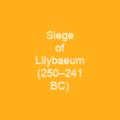Mercenary War

The Mercenary War, also known as the Truceless War, was a mutiny by troops employed by Carthage at the end of the First Punic War. It lasted from 241 to late 238 or early 237 BC and ended with Carthage suppressing both the mutiny and the revolt. The main source for almost every aspect of the Punic Wars is the historian Polybius, a Greek sent to Rome in 167 BC.
About Mercenary War in brief
 The Mercenary War, also known as the Truceless War, was a mutiny by troops employed by Carthage at the end of the First Punic War. It lasted from 241 to late 238 or early 237 BC and ended with Carthage suppressing both the mutiny and the revolt. The war began in 241 BC as a dispute over the payment of wages owed to 20,000 foreign soldiers who had fought for Carthage on Sicily. When a compromise seemed to have been reached the army erupted into full-scale mutiny under the leadership of Spendius and Matho. 70,000 Africans from Carthage’s oppressed dependant territories flocked to join them, bringing supplies and finance. The main source for almost every aspect of the Punic Wars is the historian Polybius, a Greek sent to Rome in 167 BC. His works include a now-lost manual on military tactics, but he is known today for The Histories, written sometime after 146 BC, or about a century after this war. Only part of the first book of the 40 comprising The History deals with this war, but the modern consensus is to accept it largely at face value. Modern historians also take into account the later histories of Diodorus Siculus and Dio Cassius, although the classicist Adrian Goldsworthy states that “Polybius’ account is usually to be preferred when it differs with any of our other accounts”. Other sources include inscriptions, coins and archaeological evidence.
The Mercenary War, also known as the Truceless War, was a mutiny by troops employed by Carthage at the end of the First Punic War. It lasted from 241 to late 238 or early 237 BC and ended with Carthage suppressing both the mutiny and the revolt. The war began in 241 BC as a dispute over the payment of wages owed to 20,000 foreign soldiers who had fought for Carthage on Sicily. When a compromise seemed to have been reached the army erupted into full-scale mutiny under the leadership of Spendius and Matho. 70,000 Africans from Carthage’s oppressed dependant territories flocked to join them, bringing supplies and finance. The main source for almost every aspect of the Punic Wars is the historian Polybius, a Greek sent to Rome in 167 BC. His works include a now-lost manual on military tactics, but he is known today for The Histories, written sometime after 146 BC, or about a century after this war. Only part of the first book of the 40 comprising The History deals with this war, but the modern consensus is to accept it largely at face value. Modern historians also take into account the later histories of Diodorus Siculus and Dio Cassius, although the classicist Adrian Goldsworthy states that “Polybius’ account is usually to be preferred when it differs with any of our other accounts”. Other sources include inscriptions, coins and archaeological evidence.
The Carthaginian written records were destroyed along with their capital, Carthage, in 146 BC. This has been considered to be the single greatest cause of war with Carthages breaking out again in 218 BC in the Second Punic war. Carthage was razed by Rome in a later war; its ruins lie 16 kilometres east of modern-day Tunis on the North African coast. It was the longest continuous and greatest naval war of antiquity. After the war, the Carthaginians were defeated and paid an indemnity of 3,200 talents– 1,000 talents– over ten years, due to the balance of this war being over 10 years. By the time of the war’s end Carthage had evacuated Sicily, handed over all prisoners taken during the war and paid indemnity. The First Puni War was fought between Carthage and Rome, the two main powers of the western Mediterranean in the 3rd century BC, and lasted for 23 years, from 264 to 241 BC. The conflict was the most intense of antiquity, with both sides suffering immense material and human losses on both sides. The treaty signed by Lutatius and Gisco was signed and brought the First Punic War to its end. The Second Punic War, fought between Rome and Carthage between 218 BC and 218 BC, was also the longest and greatest continual war of antiquity and lasted 23 years. It ended with Rome conquering Sardinia and Corsica, in contravention of the recent peace treaty.
You want to know more about Mercenary War?
This page is based on the article Mercenary War published in Wikipedia (as of Oct. 30, 2020) and was automatically summarized using artificial intelligence.












